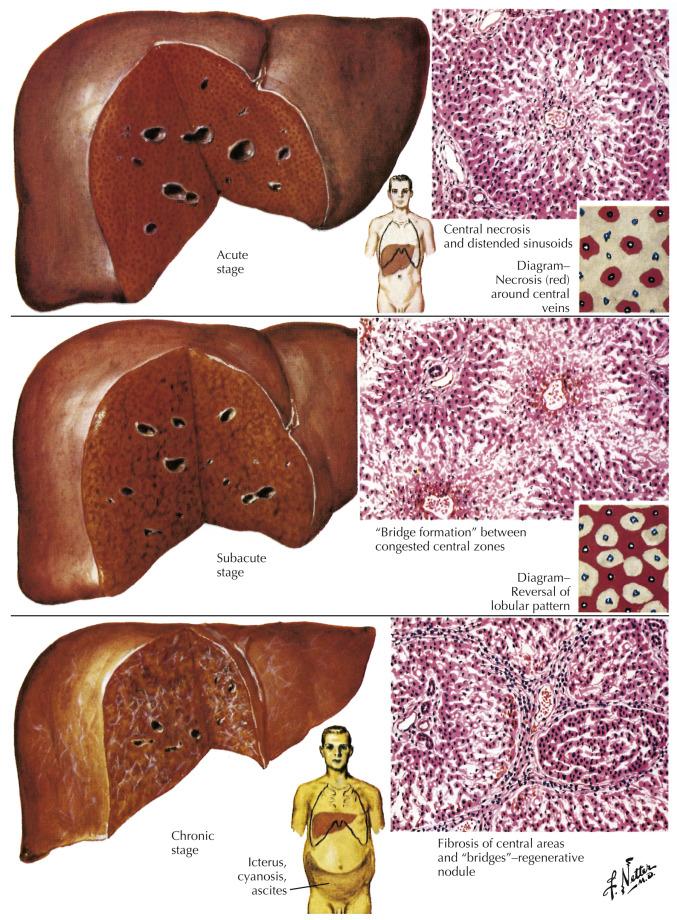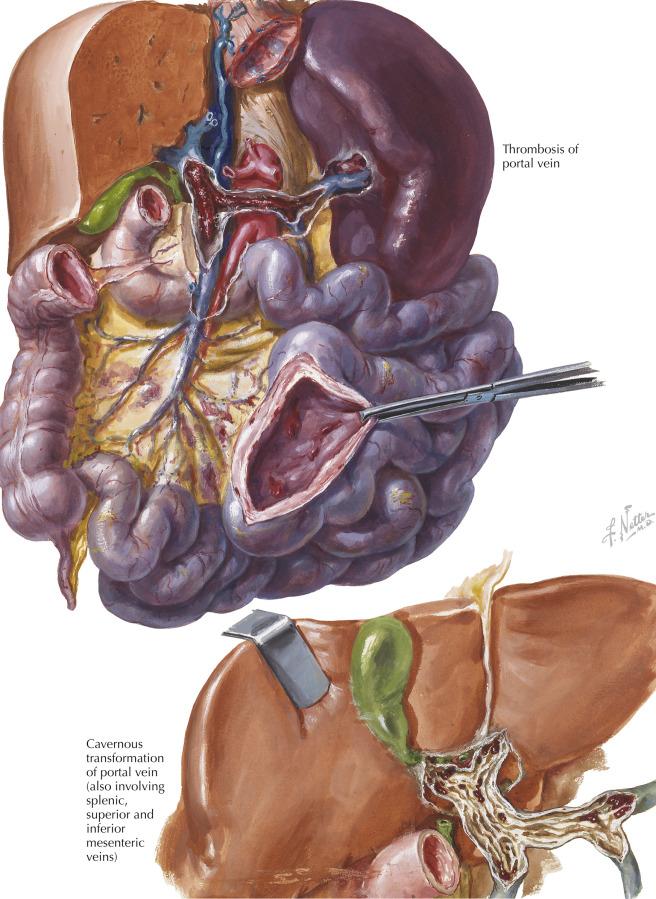Physical Address
304 North Cardinal St.
Dorchester Center, MA 02124
Secondary liver disease stemming from vascular pathology related to heart failure, portal vein obstruction, and Budd-Chiari syndrome represents clinically important conditions associated with significant morbidity and impairment of health-related quality of life.
Heart failure represents one of the more common etiologies for passive congestion of the liver, which may be associated with significant clinical sequelae. Importantly, the severity of passive liver congestion does not correlate directly with the degree of hepatic involvement.
In acute passive congestion, the liver is significantly enlarged, the capsule is tense, the anterior edge is blunt, and on the cut surface, lobular markings are much more distinct than usual ( Fig. 180.1 ). On closer inspection, the zones around the central veins appear dark red and depressed, distinct from the intermediate and peripheral zones, which may exhibit a yellow hue caused by fatty metamorphosis. The hepatic veins are extremely dilated, the liver cells in the central zone have disappeared, and both the sinusoids and tissue spaces are crowded with red blood cells, as are the dilated branches of the hepatic veins. Central necrosis is more marked on autopsy rather than on biopsy specimens.

Therefore central necrosis in a patient with heart failure may represent a terminal or a preterminal event in end-stage or severe heart failure. Occasionally, only a small rim of parenchyma is preserved on the periphery of hepatic lobules in cases of severe acute cardiac failure, such as rupture of a chorda tendinea. Clinically, the liver is very large and exquisitely tender, particularly in the gallbladder region.
In chronic passive congestion, the liver appears smaller than in the acute stages and smaller compared with normal. The surface is irregular and may be finely granular, whereas the capsule often is thickened and covered by organized fibrin. The liver may be diffusely fibrotic, and regenerative nodules may be present. The hepatic veins appear wider than in acute stages, and fibrosis may initially surround the central veins, leading to a “reverse lobular” pattern.
With progressive liver disease, bridging fibrosis may develop between central veins and portal areas, leading to established cirrhosis. True cardiac cirrhosis is the result of severe and usually long-standing passive congestion, as occurs in severe tricuspid insufficiency or constrictive pericarditis. In cardiac hepatic fibrosis, the tender liver appears relatively small, and jaundice and ascites may be present.
Patients with severe acute left ventricular heart failure may also develop acute ischemic hepatitis, characterized by high serum transaminase levels similar to those seen with shock liver, and may be associated with hypotension or hypoxemia. Jaundice and tender hepatomegaly may also develop. Some patients may have evidence of synthetic dysfunction with hepatic encephalopathy. Liver biopsy is not routinely required for diagnosis but may reveal centrilobular necrosis, which may be severe and lead to necrosis of hepatocytes in central areas, sinusoidal congestion, and a neutrophilic inflammatory infiltrate.
Most cases of portal vein thrombosis are associated with underlying cirrhosis, malignancy, or pancreatitis. An acute decrease in systemic blood pressure may also lead to portal venous obstruction ( Fig. 180.2 ). In the absence of a known cause, many cases of portal vein thrombosis may occur in association with hypercoagulable states such as polycythemia vera. Sudden, complete obstruction of the portal vein and its branches by a thrombus may lead, in rare cases, to a clinically dramatic picture dominated by hematemesis, melena with diarrhea, rapidly developing ascites, abdominal pain, peritonitis, ileus, and rapid coma and death. However, many of these patients also have associated thrombosis of the superior mesenteric vein. Jaundice is characteristically uncommon. Precipitating factors include splenectomy or other procedures involving the portal system. Portal vein thrombosis may also develop in patients during the course of cirrhosis or as a complicating feature of hepatocellular carcinoma with extrahepatic spread.

In acute portal vein thrombosis, the wall of the small intestine may also show changes, including edema and hemorrhage. The spleen is generally enlarged, but in patients without history of cirrhosis, the liver may be unremarkable. The thrombosis may originate from the portal vein itself or may extend into it from a splenic or a mesenteric vein thrombus or distally from thrombi in the intrahepatic branches of the portal vein.
A more gradual decrease in the portal circulation is well tolerated, possibly because of the development of collaterals. The thrombosis may result in cordlike shrinkage of the portal vein or a spongy cavernous transformation caused by recanalization of the thrombus itself. The liver shows minimal changes in isolated portal vein thrombosis, and jaundice is usually absent. The main complication, variceal bleeding, is generally better tolerated than in patients with cirrhosis. Ascites may be present.
Extrahepatic portal vein obstruction is common in developing countries, particularly India, and is a common cause of noncirrhotic portal hypertension. It is associated with extensive collateral circulation around the portal vein, leading to formation of ectopic varices in the peribiliary and peripancreatic regions. Variceal hemorrhage is the most common complication.
Treatment of portal vein obstruction focuses on managing the complications of portal hypertension. In patients without an underlying history of cirrhosis, a workup for a hypercoagulable state is indicated. Endoscopic therapy is effective for patients with variceal bleeding, and portal decompression is appropriate for patients with preserved hepatic synthetic function. Transjugular intrahepatic portosystemic shunt (TIPS) has been used in some patients with portal venous obstruction, especially when the acute portal vein thrombosis is associated with Budd-Chiari syndrome.
Become a Clinical Tree membership for Full access and enjoy Unlimited articles
If you are a member. Log in here